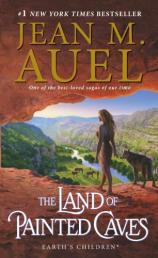The Land of Painted Caves
Review
The Land of Painted Caves
A novel that moves at glacial speed, with numerous cyclic repetitions and more than 100 pages between major plot turns, sounds like a recipe for marketing disaster and instant boredom. And if written by anyone but Jean M. Auel, such a book would likely not see the light of day. But THE LAND OF PAINTED CAVES is yet another example of its author's flair for turning the rules inside out and leaving readers mesmerized.
At a time when a brief fad for incredibly (often unnecessarily) long fantasy novels was taking hold, Auel suddenly emerged on the scene with, of all things, a substantial and surprising Ice Age tale, THE CLAN OF THE CAVE BEAR. It was a hit, to be followed at suspenseful intervals --- from two to nine years --- by five more titles in her epic Earth's Children series.
Neither archaeologist nor anthropologist by training (she turned to writing after earning an MBA and then opting out of a career in banking), Auel has much in common with Britain's renowned Jane Goodall, whose passion for studying wild chimpanzees and apes took hold when she was a lowly teenaged secretary with no formal qualifications in any field. Both women quietly bypassed authority and academic precedent to focus their creativity, imagination, diligent research and consuming passion on the subjects they love. In both cases, their internationally respected work --- factual and fictional --- has given the world priceless gifts of insight and new knowledge.
In reading Auel, whether for the first or sixth time, one is immediately conscious of her unique ability to cut through veiled speculation about human life before "history." On their own, a vivid artistic imagination or methodical fact-driven reportage could not come close to the rich sensory fabric of a tale like THE LAND OF PAINTED CAVES. Auel's fusion of painstaking research with a deeply personal human drama highlights not only the significance of authenticated pre-historical data concerning climate, geology and sociological development, but places those distant facts into an immediate reality that wholly informs the thoughts and actions of her characters.
We are never told, for example, that Ayla's tribe, the composite hunter-gatherer Zelandonii people of modern-day southeast France and northern Italy, have no concept of the wheel. Instead, we learn how she and mate Jondalar discover how to ride the sturdy ice-age horses that roamed the area 25,000 years ago and invent a travois frame that allows the animals to drag heavier loads than humans can carry. Auel subtly conveys that such commonplace concepts --- no less than discovering the basic biology of fertilization and child-bearing --- were revolutionary to people for whom spoken language was still a novelty and written literacy barely embryonic.
The unique interweaving of spirituality, visual art and the healing arts is by far the greatest achievement of Auel's six-book epic, but no more so than in THE LAND OF PAINTED CAVES, where Ayla, as a spiritual leader-in-training, experiences the overwhelming power of a universal Mother who gave birth to everything in the universe. The Mother's presence is intimate rather than distant, breaking into her people's consciousness through visions that become community songs, stories and symbols. For Ayla's people, her special dwelling-places are the caves, which become a mystical nexus for creativity and revelation, resulting in myriad drawings and symbols whose remnants today astonish all who see them.
So vivid and detailed are Auel's imaginative journeys through the dawn of human society that anthropology and archaeology professors often recommend her novels to their students. In doing so, they are sharing an invaluable message that behind every shard, fragment, artifact or obscure symbol of ancient times, were real humans --- our unnamed ancestors. And that is no fiction.
Reviewed by Pauline Finch on March 29, 2011
The Land of Painted Caves
- Publication Date: November 22, 2011
- Genres: Fiction, Historical Fiction
- Mass Market Paperback: 848 pages
- Publisher: Bantam
- ISBN-10: 0553289438
- ISBN-13: 9780553289435





